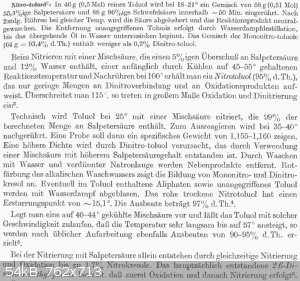| Pages:
1
2
3 |
Fery
International Hazard
    
Posts: 1015
Registered: 27-8-2019
Location: Czechoslovakia
Member Is Offline
|
|
S.C. Wack do you mean using 91% IPA for recrystallization of mixture of dinitrotoluene isomers, or recrystallization of 4-nitrotoluene?
For removing unreacted toluene I suggest vacuum distillation, without vacuum you have to heat the mixture much higher than b.p. of toluene which
caused darkening of obtained dinitrotoluenes. For separation of mono and dinitro the distillation in vacuum is must to go, literature claims that in
industry explosion disasters were reduced when heating dinitro only upto 190 C (and b.p. of mononitro isomers are in range approximately 220-230 C at
atmospheric pressure). It would be nice to have lab. scale preparation without dinitro formation. I do not see usefulness of 2,4 dinitrotoluene in
home lab - maybe oxidation with dichromate+H2SO4 to 2,4 dinitrobenzoic acid, then decarboxylation into meta dinitrobenzene (which could be synthesized
form nitrobenzene but the nitration requires fuming nitric acid so this preparation is not trivial) and then reduction to 3-nitroaniline.
|
|
|
S.C. Wack
bibliomaster
    
Posts: 2419
Registered: 7-5-2004
Location: Cornworld, Central USA
Member Is Offline
Mood: Enhanced
|
|
IPA from the store is so good at crystallizing things with little solubility in water (usually better than other alcohols) that I've run out of it and
have to buy some more. I had 4 separate solid layers and good crystals with the 60% acid product but have not taken the mp's. It's mostly p-NT. I have
an idea for oxidation with Cr to try out.
If one has little toluene left, with good vacuum it can be difficult to condense, ending up in the pump. For sure the SOC direction can be followed
even if one substitutes the 1.44 acid with weaker acid (without increasing the sulfuric) or adds toluene to acid, as it also calls for distilling only
the first 40%.
PS the relevant part of Houben-Weyl (vol 10 part 1) (BTW this mononitration of monoalkyl aromatics section starts out talking about 1 eq HNO3 in mixed
acid of 10-15% water at 20C, not the 20% water of the Belgian reference 2 that starts this and does not give that yield with that nitric ratio
IME...PS2 note the workup hint):

[Edited on 19-4-2021 by S.C. Wack]
|
|
|
S.C. Wack
bibliomaster
    
Posts: 2419
Registered: 7-5-2004
Location: Cornworld, Central USA
Member Is Offline
Mood: Enhanced
|
|
I'm beginning to doubt this, as a large fraction recrystallized 3x from n-propanol has a mp of 66C (2,6 dinitrotoluene)...all the less solubles give a
strong positive for DNT...It's entirely possible that the 91% IPA gave a positive DNT test because of acetone in it...not sure if it was made from
acetone or what...not sure what caused dinitration either, maybe with the water and magnetic stirring, the nitrotoluene was better able to dissolve in
the acid than the toluene. If I had nothing else to do I'd try adding something to get better contact and see what that does.
|
|
|
Fery
International Hazard
    
Posts: 1015
Registered: 27-8-2019
Location: Czechoslovakia
Member Is Offline
|
|
S.C. Wack - I have some mixture of dinitrotoluenes from mother liquor after etanol recrystallization of 2,4 dinitrotoluene (identified by m.p. which
is the same as lit. m.p.). So do you suggest to recryst my remainder mixture from 1-propanol to obtain 2,6 dinitrotoluene which is enriched in my
mixture (after I obtained 2,4 dinitrotoluene)? Or 91% IPA?
|
|
|
S.C. Wack
bibliomaster
    
Posts: 2419
Registered: 7-5-2004
Location: Cornworld, Central USA
Member Is Offline
Mood: Enhanced
|
|
It's rather hard to say as I don't have any IPA, or mixtures of isomers it seems...the entire less soluble fraction has a mp of 66C regardless of how
many times it's been crystallized, whether it's (faintly) chlorine yellow or brown. It should be mentioned that these odorless needles are insoluble
in water with or without base, the thermometer was tested with boiling acetone, (PS the toluene was pretreated per Vogel, probably unnecessarily) and
the mag stirring was as intense as mag stirring can be...it is the 2,6 version, and a lot of it. This explains why there was no o-NT in the waste
acid, and not much anywhere else; it was nitrated preferentially over the p. A hint for why this might be was found in IEC 785 (1955) (Mononitration
of o and p-nitrotoluene), where it is said that both are nitrated with ease, but not so much the p-NT, with smaller amounts of sulfuric acid.
[Edited on 23-4-2021 by S.C. Wack]
|
|
|
S.C. Wack
bibliomaster
    
Posts: 2419
Registered: 7-5-2004
Location: Cornworld, Central USA
Member Is Offline
Mood: Enhanced
|
|
PS: 91% IPA (still more expensive than 2 years ago, could be permanent) + refrigeration gave better crystals than n-propanol under the same
conditions, especially p-nitrotoluene. That slight brownness to my DNT was cleared up perfectly by boiling for a couple minutes in IPA with
decolorizing carbon. This gave long and hair-thin, colorless (until it turned chlorine yellow on drying in the window) transparent needles. The p-NT,
already melting correctly and yellow, gave considerably thicker and slightly longer needles, which are also different than the DNT in being pretty
much white (opaque), with the slightest hint of chlorine yellow, without decolorizing. And of course the strong smell of MNT.
With second thoughts about using sulfuric acid as solvent for oxidizing the p-NT (w/ Cr+6) because of all the OS warnings already with more dilute
acid, KMnO4 was used...the o- would be more convenient either way, as some solid p-NT will be found in cold reflux condensers...Zn/bisulfite will be
tried for PABA. (edit: wow...that was easy; the whole off-topic sequence from after isolating the p-NT to before isolating the PABA)
[Edited on 3-5-2021 by S.C. Wack]
|
|
|
| Pages:
1
2
3 |